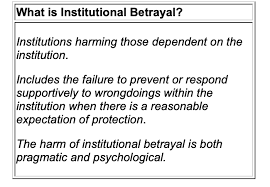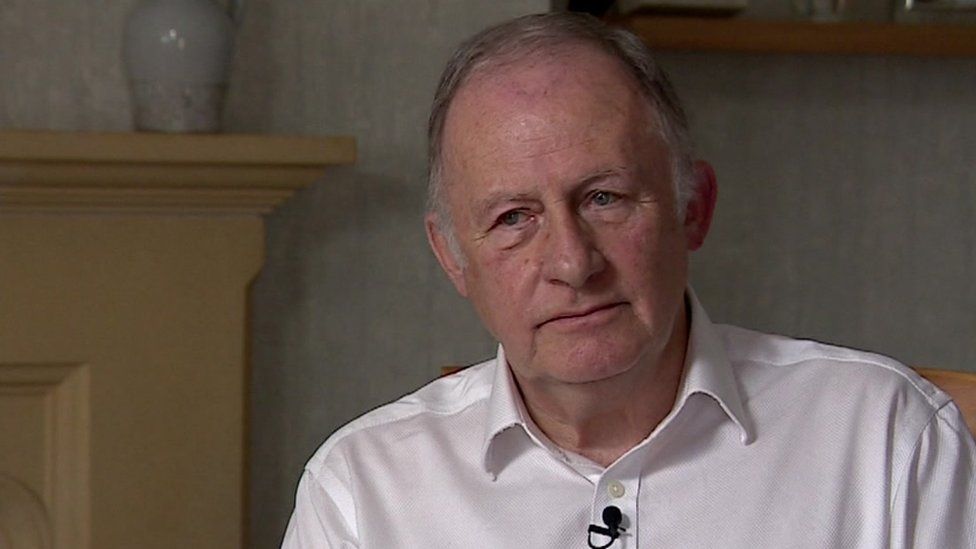by Fiona Gardner

‘It is a helpful resource, which will be added to, but also a challenge to us all @churchofengland to continue to do better.’
So writes Stephen Cottrell, Archbishop of York on the House of Survivors website. I couldn’t agree more … but after all this time it isn’t only a challenge but also an imperative ‘to do better’, because Stephen Cottrell is talking about a deeply embedded culture of institutional betrayal, a betrayal that compounds the original abuse and trauma. What both House of Survivors and Surviving Church do is highlight example after example of this. Over the years the institutional church has tended to emphasise individual situations, as if they were isolated incidents from which particular lessons can be learned. What gathering all the data together shows is that the problem is systemic, and the institutional betrayal partly occurs because reputation is valued over the well-being of the members, and issues of power and control dominate.
Institutional betrayal as a concept has been around for a while, and is the term used when an institution causes harm to an individual who trusts and has been encouraged to depend upon that institution. Betrayals are violations of trust and dependency perpetrated by the institution. There’s another interesting concept about the ‘organisation-in-the-mind’ – in this context this is about the idea of church, how we think and imagine the church, so it becomes a bit of constructed social reality – this is not to do with the buildings, or services, or activities. The church-in-the-mind will clearly differ: for example, the church is a sacred and safe place full of people who are kind and compassionate, and I will be welcomed. Or, the church is a place of judgement and bigotry where I won’t fit in. Generally, though, assumptions of trust, safety and dependency are implicitly encouraged by the whole church culture and by the hierarchy.
Therefore, for the survivor of clergy abuse there is a double betrayal by the institution: the first is the original criminal abusive act from someone in a position of trust; the second is the inadequate and re-traumatising response by the member of the church hierarchy who has heard the disclosure. This is secondary victimization. The painful part is that when someone reaches out for help after abuse, they are already placing a great deal of trust in the system as they risk disbelief, blame and refusals of help. To report the abuse brings the conflict of potentially losing the sense of belonging within church community, but to not report risks the abuse continuing and a denial of the traumatic reality.
The concept of institutional betrayal arises from betrayal trauma theory, that traumas perpetrated within a previously trusted and dependent relationship are remembered and processed differently to other traumas. Research shows that the impact of institutional betrayal includes further psychological distress, anxiety, dissociation, etc. If re-traumatisation occurs through institutional betrayal the original trauma is compounded, and so once again the victim’s mind is overwhelmed with more than it can make sense of and manage. The organization that encouraged trust and dependency is revealed to be careless, unconcerned or more actively destructive. Betrayal blindness may sometimes be displayed by all involved in order to preserve relationships, institutions, and social systems upon which they depend. In other words, institutional betrayal may be minimised not only by the church hierarchy (for example saying – that was then and now it is different, or we must continue to do better), but also sometimes by the victim who defends against the reality by remaining hopeful that their needs may still be recognised and met.
Whilst it may appear that an experience of institutional betrayal is less visible, it is not less injurious than the original abuse. It’s all about the social dimension of trauma, independent of the individual’s reaction to the event, and the way events are processed and remembered is related to the degree to which the traumatic event represents a betrayal by a trusted, needed other, and this is whether it is an individual or institution – or as in many situations both. Institutional betrayal by the church on top of an original abusive act is a kind of breakdown of the organisation-in-the-mind. It is a massive attack on an established way of going about one’s life, of established beliefs about the predictability of the world, of established mental structures.
Institutional betrayal can happen through acts of commission in which the institution takes action that harms its members, for example by actively protecting an abuser. It can also betray through acts of omission, in which the organization fails to take actions that could protect members, for example taking no appropriate action and ignoring guidelines.
Here’s an example of institutional betrayal that includes both commission and omission:
On May 20 2022, a letter was published in The Church Times by “Graham” about the Church of England’s continued and chronic lack of response to the serious abuse carried out by the late John Smyth QC. Thanks to Andrew Graystone’s research, we know that the lengthy suppression of information and accountability is complex. The abuse was known about since 1982, the perpetrator protected, and victims unheard and denied justice (acts of commission). As Stephen wrote on this website in March 16, 2020:
Many individuals were part of the story, not just as bystanders, but sometimes as active colluders. … There were many high up in the network who knew what was going on. The failure of a single one to come forward, suggests that the word conspiracy is an accurate one to describe this corporate behaviour.
In May 20 2021, nine years after being told of the abuse, the Archbishop of Canterbury met with some of the victims, and promised investigations would take place into those who colluded with the cover-up. In his letter “Graham”, a year later, writes:
As a victim, I regard the archbishop’s words as appearing to be just hot air: promises unfulfilled. Has he “kept in touch” with these investigations, as he claimed he did in 2013? Or has he just assumed that someone else is dealing with it, which he described at IICSA as “not an acceptable human response, let alone a leadership response”.
Justin Welby responded in The Church Times on the June 10 2022 stating, that delays to both the Church-led and independent investigations were unintentional and being followed up (acts of omission).
Here are the usual dynamics of deception that appear to have underpinned the way that the institutional church has systemically betrayed survivors and their supporters. As with “Graham”, many of the abused remain victims (in his case ten years after he publicly disclosed), victims not only of the original crime, but also victims of emotional and spiritual abuse from the church’s inadequate and neglectful response: victims also of institutional betrayal.
The sheer neglect and lack of validation shown by this example mirrors the deep lack of validation by the perpetrator, and clearly compounds the damage. Justin Welby illustrates a process of cognitive re-framing to turn the destructive non-responding into somehow being morally acceptable by employing the defensive manoeuvres that it was ‘unintentional’ – what does that mean? Perhaps he is displacing and projecting the responsibility onto someone else, or another part of the system. Similar to the behaviour of some perpetrators the methods involving such acts of omission usually include obfuscation, rationalisation and denial. It also suggests an element of sadism, where the aim is (no matter how many years it takes) perversely to oppose and thwart and to obstruct. The above example, as with other betrayals, is undeniably to halt the course of events, to favour inertia – and, as in abuse to rub out and negate the wishes of the other person.
Andrew Graystone in Falling Among Thieves notes that the centripetal power of orthodoxy has meant that whatever is done to address issues of abuse in the church has been done without changing anything substantive in its culture, practice, or theology. Consequently, much is done, but little changes – lofty statements are made, but to no effect. This is because change can only emerge when the current situation is honestly faced. Abusive cycles of institutional betrayal are hard to break, and to do so requires motivation and energy. To not do so is to embrace apathy and group laziness as an avoidance of acknowledging self-deception and the reality. The institutional church is still stuck in a collusive refusal to know or to pursue and examine the truth that certain destructive traits have dominated actions. Inept and inhumane responses damage, and those who are damaged have seriously suffered, but the damage has also been to the system. Betrayal – a central theme in the Passion narrative, and now a central theme in the institutional response to abuse gets re-enacted systemically again and again. The hope then lies in organizational redemption which demands authenticity, humility to take on constructive criticism, and astute integrity with soul-searching at the very top of the church hierarchy. Organizational redemption corrects the past wrongs of institutional betrayal, a debt is repaid, and hope restored.








